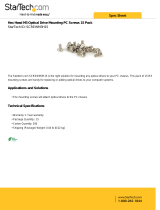
Removing a 5.25-inch drive ............................................................................................... 28
Installing a 5.25-inch drive ................................................................................................. 29
Removing a 3.5-inch device .............................................................................................. 32
Installing a 3.5-inch device ................................................................................................ 34
Removing a slim optical drive ............................................................................................ 36
Installing a slim optical drive .............................................................................................. 37
Removing a 3.5-inch or 2.5-inch hard drive ....................................................................... 40
Installing a 3.5-inch or 2.5-inch hard drive ......................................................................... 41
Installing a security lock ..................................................................................................................... 46
Cable lock .......................................................................................................................... 46
Padlock .............................................................................................................................. 46
HP business PC security lock ............................................................................................ 47
Front bezel security ........................................................................................................... 51
3 Small Form Factor (SFF) hardware upgrades ............................................................................................ 53
Serviceability features ........................................................................................................................ 53
Warnings and cautions ....................................................................................................................... 53
Removing the computer access panel ............................................................................................... 54
Replacing the computer access panel ............................................................................................... 55
Removing the front bezel ................................................................................................................... 56
Removing bezel blanks ...................................................................................................................... 57
Replacing the front bezel .................................................................................................................... 58
Changing from desktop to tower configuration ................................................................................... 59
System board connections ................................................................................................................. 60
Installing additional memory ............................................................................................................... 61
DIMMs ............................................................................................................................... 61
DDR3-SDRAM DIMMs ...................................................................................................... 61
Populating DIMM sockets .................................................................................................. 61
Installing DIMMs ................................................................................................................ 62
Removing or installing an expansion card .......................................................................................... 64
Drive positions .................................................................................................................................... 68
Installing and removing drives ............................................................................................................ 69
Removing a 3.5-inch device .............................................................................................. 71
Installing a 3.5-inch device ................................................................................................ 73
Removing a slim optical drive ............................................................................................ 76
Installing a slim optical drive ..............................................................................................
77
Removing and replacing a 3.5-inch hard drive .................................................................. 78
Removing a 2.5-inch hard drive ......................................................................................... 82
Installing a 2.5-inch hard drive ........................................................................................... 84
Installing a security lock ..................................................................................................................... 87
Cable lock .......................................................................................................................... 87
vi ENWW





















